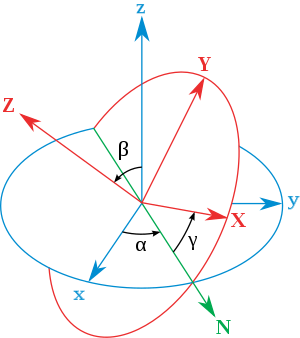
Back زوايا أويلر Arabic Angles d'Euler Catalan Eulersche Winkel German Γωνίες Όιλερ Greek Ángulos de Euler Spanish Eulerren angeluak Basque زاویههای اویلر Persian Angles d'Euler French Na huillinneacha Euler Irish זוויות אוילר HE

Fixed coordinate system (x, y, z)
Rotated coordinate system (X, Y, Z)
The Euler angles are three angles introduced by Leonhard Euler to describe the orientation of a rigid body with respect to a fixed coordinate system.[1]
They can also represent the orientation of a mobile frame of reference in physics or the orientation of a general basis in three dimensional linear algebra.
Classic Euler angles usually take the inclination angle in such a way that zero degrees represent the vertical orientation. Alternative forms were later introduced by Peter Guthrie Tait and George H. Bryan intended for use in aeronautics and engineering in which zero degrees represent the horizontal position.